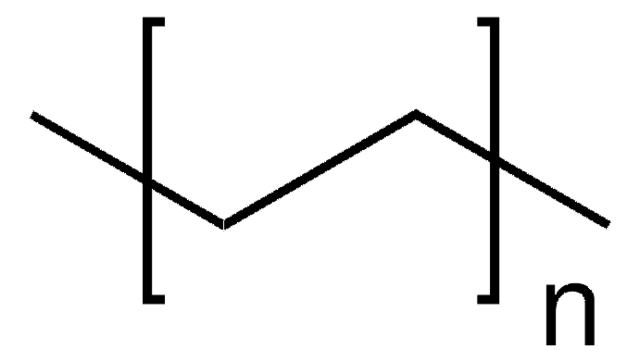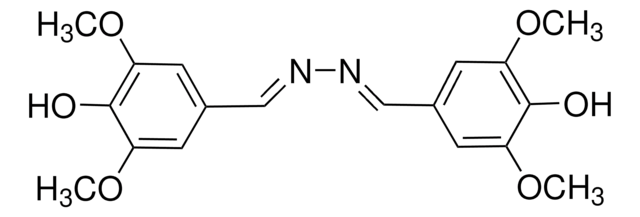182427
Polystyrene
average Mw ~280,000 by GPC
Synonyme(s) :
PS
Se connecterpour consulter vos tarifs contractuels et ceux de votre entreprise/organisme
About This Item
Formule linéaire :
[CH2CH(C6H5)]n
Numéro CAS:
Numéro MDL:
Code UNSPSC :
12162002
ID de substance PubChem :
Nomenclature NACRES :
NA.23
Produits recommandés
Forme
beads or pellets
Niveau de qualité
Poids mol.
average Mw ~280,000 by GPC
Indice de réfraction
n20/D 1.5916
Température de transition
Tg 100 °C
Densité
1.047 g/mL at 25 °C
InChI
1S/C8H8/c1-2-8-6-4-3-5-7-8/h2-7H,1H2
Clé InChI
PPBRXRYQALVLMV-UHFFFAOYSA-N
Vous recherchez des produits similaires ? Visite Guide de comparaison des produits
Description générale
Polystyrene is a high molecular weight aromatic synthetic polymer madefrom the polymerization of styrene. It is a hydrophobic durable thermoplasticwidely used in food containers, packaging foam, and construction materials dueto its good mechanical properties and low cost.
Application
Polystyrene can be added to nanocatalyst suspension to prepare a polystyrene-photocatalyst thick film. This film can be used as a photoanode in an airlift photocatalytic fuel cell (APFC).
Polystyrene can be used as a precursor to prepare graphene film and 3D graphene sponges by pyrolysis under argon atmosphere. The filmogenic property of polystyrene can be exploited to prepare 3D graphene sponges with uniform pore sizes.
It can also be used to prepare dyed polystyrene (PS) film for routine dosimetry in radiation processing. Dyed PS film has high post-irradiation stability.
Polystyrene can be used as a precursor to prepare graphene film and 3D graphene sponges by pyrolysis under argon atmosphere. The filmogenic property of polystyrene can be exploited to prepare 3D graphene sponges with uniform pore sizes.
It can also be used to prepare dyed polystyrene (PS) film for routine dosimetry in radiation processing. Dyed PS film has high post-irradiation stability.
Code de la classe de stockage
11 - Combustible Solids
Classe de danger pour l'eau (WGK)
WGK 3
Point d'éclair (°F)
Not applicable
Point d'éclair (°C)
Not applicable
Équipement de protection individuelle
Eyeshields, Gloves, type N95 (US)
Faites votre choix parmi les versions les plus récentes :
Déjà en possession de ce produit ?
Retrouvez la documentation relative aux produits que vous avez récemment achetés dans la Bibliothèque de documents.
Les clients ont également consulté
Alejandra Rendón-Patiño et al.
Nanomaterials (Basel, Switzerland), 9(1) (2019-01-19)
Polystyrene as a thin film on arbitrary substrates or pellets form defective graphene/graphitic films or powders that can be dispersed in water and organic solvents. The materials were characterized by visible absorption, Raman and X-ray photoelectron spectroscopy, electron and atomic
Hui Xia et al.
Journal of colloid and interface science, 376(1), 322-326 (2012-03-27)
The aggregation kinetics of particles in dense polystyrene latex suspensions is studied by low-coherence fiber optic dynamic light scattering. Low-coherence fiber optic dynamic light scattering is used to measure the hydrodynamic radius of the aggregates. The aggregation kinetics data obtained
Harikrishnan Narayanan Unni et al.
Electrophoresis, 30(5), 732-741 (2009-03-05)
This study reports a theoretical and experimental study on the irreversible deposition of colloidal particles from electrokinetic microfluidic flow. The electrokinetic particle transport model presented in this study is based on the stochastic Langevin equation, incorporating the electrical, hydrodynamic, Derjaguin-Landau-Verwey-Overbeek
Liang Zhang et al.
Journal of colloid and interface science, 353(2), 557-561 (2010-10-30)
Reported are adsorption isotherms for guar and hydroxypropyl guar (HPG), with and without the presence of borate ions, onto surfactant free anionic polystyrene latex. Guar and HPG formed adsorbed monolayers on the hydrophobic latex. The presence of borate ions converted
Katherine Sarlo et al.
Toxicology, 263(2-3), 117-126 (2009-07-21)
Understanding tissue distribution and clearance of nanomaterials following different routes of exposure is needed for risk assessment. F344 female rats received single or multiple exposures to 20 nm, 100 nm or 1000 nm latex fluorospheres by intravenous (i.v.) injection or
Notre équipe de scientifiques dispose d'une expérience dans tous les secteurs de la recherche, notamment en sciences de la vie, science des matériaux, synthèse chimique, chromatographie, analyse et dans de nombreux autres domaines..
Contacter notre Service technique




